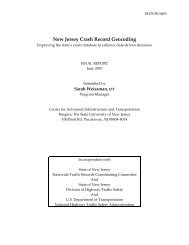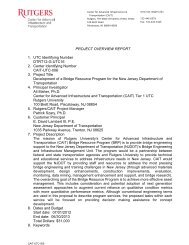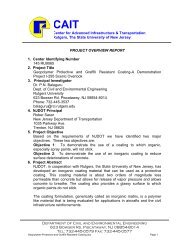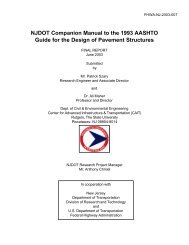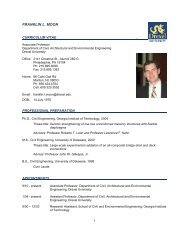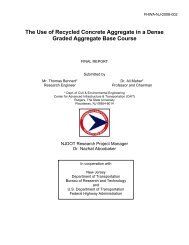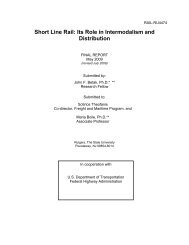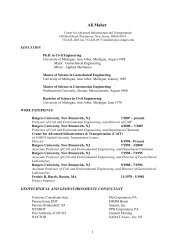ROADSIDE INSPECTION DATA AND CRASH DATA ANALYSIS - CAIT
ROADSIDE INSPECTION DATA AND CRASH DATA ANALYSIS - CAIT
ROADSIDE INSPECTION DATA AND CRASH DATA ANALYSIS - CAIT
Create successful ePaper yourself
Turn your PDF publications into a flip-book with our unique Google optimized e-Paper software.
Roadside inspection and crash data analysisreturned to BSP. Images of the NJTR-1 forms, which are used during the verificationprocess, are then uploaded to the New Jersey Department of Treasury Filenet Program.At the BSP, the data from the NJTR-1 forms are loaded from the data disk to a raw datatable. The crash data for each crash report is verified by the BSP staff. Images of theoriginal crash report are compared to the data that CTI has transcribed. In addition tothe verifier efforts, there are numerous other program edits that help with the erroridentification and verification process. The verification program edits identify errorsthrough color coding in red, yellow, and green fields that require additional attentionand/or approval. If a field is flagged for modification, the verifier reviews the image ofthe NJTR-1 form to determine what information should be in the corresponding datafields. If a field is flagged but there is no need to modify any information, the verifiermust accept changes made by the ARD application. The verifier then continues toverify the remaining fields. Every night the data that was verified that day goes througha nightly programmatic run that geo-codes the records and downloads it into the ARDproduction server. After these steps are completed, all crash records meeting FMCSAreportable crash criteria are exported to an ASCII text file and e-mailed to the BTS.At the BTS, the ASCII file is input into SAFETYNET. This process creates a log filewhich summarizes the results of the import. This file is then reviewed for errors andwarnings which may have occurred during in the import of the data. If there are fatalerrors listed in the log file, the ASCII text file is corrected using the SAFETYNET CrashFile Editor and the data merging process is re- run to import these corrected records.If there are no fatal errors listed in the log file or if they have previously been corrected,the SAFETYNET operator checks if there are any zip code or any other type ofwarnings listed in the log file. If this is the case, a set of queries are run in an attempt toprovide the information missing from the crash records. This information could includeunmatched crashes, intrastate with USDOT number, crashes with blank zip codes, orcrashes with passenger vehicles incorrectly marked as hazardous material carriers. Allof these records are then corrected by modifying them in SAFETYNET.After all errors are corrected, the SAFETYNET matching process is conducted on eachnew record. Those carriers that are not automatically matched during this process aresearched in the local SAFETYNET census file to allow for a match. After this process iscompleted, an export file is created by SAFETYNET and is electronically transferred tothe MCMIS FTP site. This transfer creates a communication log file which is checkedby the SAFETYNET operator for any fatal errors. If no fatal errors are found the crashrecord processing is completed. If the log documents any fatal errors, the error is thencorrected in SAFETYNET and the transfer is repeated.9



